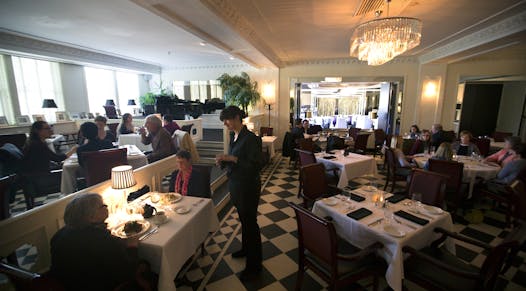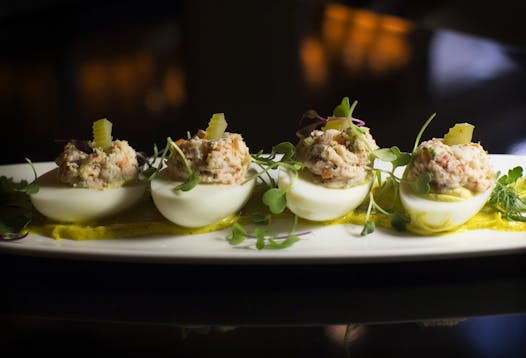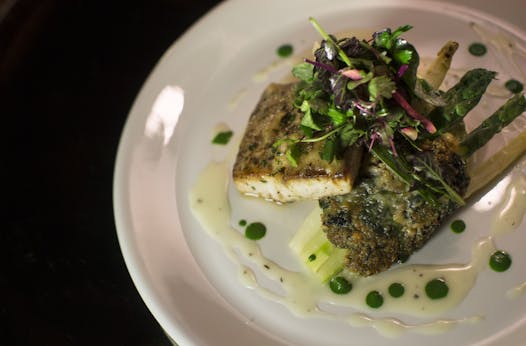We were in the middle of another pleasant dinner at the Commodore Bar and Restaurant, when my pal summed up the food in a way that instantly framed our experience, and reminded me why we're friends.
"It's like we're at a wedding," he said. "A really nice wedding."
Maybe. To me, the cautious, no-surprises menu feels as if owner John Rupp is asking chef Chris Gerster to cater to the 651 demographic that lost its clubhouse when the Lexington closed nearly three years ago.
With one key exception: The Lex's autopilot comfort food was never this technically astute, or seasonally aware. But it was similarly risk-averse, and anyone expecting to encounter a jazzed-up menu to match the Commodore's fizzy Jazz Age decor is going to be disappointed.
That's not to say that they won't be satisfied.
It's probably inevitable that Gerster would be charged with creating historically appropriate dishes to complement the surroundings. Fortunately, when he delves deep into the past, the results aren't a verbatim re-creation, because nothing ages faster than a period piece.
A great example is the Waldorf salad, that standard-setting mix of apples, celery, walnuts and mayonnaise. Gerster brightens the combination considerably by invoking a sweet-and-sour flourish: candied walnuts, wine-poached raisins and pickled celery hearts.
Rather than a one-note mayo, he infuses Greek yogurt with another agrodolce-esque element: an invigorating splash of lemon and a hint of honey. For added crunch (and color), there's crispy romaine lettuce and tart apples. It's light and refreshing, and it delivers that requisite dose of nostalgia without going overboard.
Then Gerster got to thinking about the combination of carrots, sunflower seeds and ranch dressing that is a go-to salad with his kids. What could he do with that? Plenty, as it turns out.
It begins with butter lettuce, the flat, delicate leaves layered like a stack of flapjacks. Slivers of crisped ham and those sunflower seeds are added for textural relief. Then out comes a subtle twist on that sweet-and-sour leitmotif; the oven unlocks sugars buried deep within carrots, and tangy goat's milk retools ranch dressing expectations.
It's wonderful. Even better? Both salads are available in two diner-friendly sizes and prices.
A glimpse into 1934
The Commodore, with its steeped-in-F. Scott Fitzgerald aura, more than earns the oohs and aahs that are reflexively uttered when natives of a certain age encounter its fabled name.
The post-Prohibition beauty had spent the past several decades as a private events space until Rupp — who also operates the nearby W.A. Frost & Co. — kicked it back open to the public last fall. For his efforts, here's hoping he's showered with preservationist-minded accolades. He deserves them.
Yes, the glorious art deco bar, with its luminous metallic ceilings, funhouse mirrors and ageless black-and-white palette, lives up to its legend, and then some.
It's much more compact than I'd remembered. Perhaps Rupp felt the same way, because he's wisely opened up the surrounding real estate, installing a series of lounges that echo the bar's Fred-and-Ginger style without resorting to theme-park caricature (OK, the endless movie-star photos and incessant Big Band music get to be a bit too literal). This puffed-up Commodore is the proud equivalent of a classic big-city hotel lobby, a venue that the Twin Cities sorely lacks. Until now.
The overall effect is sophisticated but not off-puttingly fancy-schmancy. Spending time in any of these rooms is a pleasure, what with their intimate scale, flattering lighting and — shocker of shockers — acoustics that enable actual conversation.
No wonder diners have responded by flooding the place, making the Commodore a genuine tough-to-snare reservation. (Here's a tip: Tables in the lounge that sits opposite the white-tablecloth dining room are available solely on a first-come, first-served basis.)
Another plus: Although the Commodore looks expensive, it isn't. A bargain? No. But a populist thread runs through its pricing structure, and how great is that?
"Maintaining a moderate price point is important to me," said Gerster. "Restaurants can't survive if people can't afford to eat at them."
What (and what not) to order
Back to the food. The menu — it's one of those awkward, annoyingly cumbersome, catalog-sized things — has a straightforward format: a shortlist of appetizers, a few salads, a handful of sandwiches, eight large-format plates and six desserts.
It's puzzling that, for such a cocktail-centric operation there's such a limited number of nibble-and-graze options.
What's there is more than acceptable. Deviled eggs are enriched with gently poached lobster. Delicate croquettes boast a sneaky pork bite. Another classic, a salmon tartare, boasts simple but spot-on embellishments.
Gerster — who counts chefs Alex Roberts, J.P. Samuelson and Stewart Woodman as mentors — prepares one of the Twin Cities' better shrimp cocktails. He preserves their jumbo size and firm snap by carefully poaching them in an aromatic court-bouillon; just before serving, they're given an oh-so-subtle toss in olive oil, salt and chives. Perfect.
A trio of oversized crostini exhibit all kinds of promise (although the breads were so hard they frequently called for a chisel rather than a knife), with intriguing flavor combinations (a smear of ricotta with bacon, fig and lemon, or a rich rabbit rillettes accented with pickled radishes), and they make you hungry for more of the same.
Gerster has an obvious flair for seafood (his mahi-mahi and sole entrees are the menu's most contemporary efforts), and his approach to duck — a big, meaty breast, dancing with fennel and orange accents — makes a positive impression. A does-the-trick burger, blanketed in decadent Gruyère, plus rosemary- and Parmesan-dusted French fries, more than fulfill their duties as hoity-toity removers.
But the two most memorable entrees boast historical precedents. One is a pork schnitzel, the loin brined, pounded, panko-breaded and deep-fried until the outer crust crackles while the meat remains juicy and flavorful.
Like so much of Gerster's well-balanced cooking, the fryer's heavy-handedness is lessened by pops of a brightly peppery lemon vinaigrette.
The other standout is a clever play on the near-ubiquitious cauliflower gratin, filtered through 1930s Indian-American cooking.
Some dishes cried out for attention. Witness the arancini-like risotto balls, which displayed all the proper textural qualities but virtually none of the promised saffron seasoning.
Or the annoyingly stale breads. Or the pickled vegetables, overpowered by a biting vinegar. Or the creamy, wonderfully earthy mushroom risotto, curiously topped with Cheez-It-like crunchies.
Others just flat-out flopped. When "mushy" is the only adjective that comes to mind regarding a flavor-free veggie burger, you know it's time to start over. Oh, and this is not the place to drop $34 on a New York strip.
At $6 a pop, the serviceable desserts — lemon tart, crème brûlée, cheesecake — are notably inexpensive. My favorite? The well-sourced (and well-priced) cheese plate.
Rupp recruited well. Along with Gerster, there's general manager Lorin Zinter. The Heyday and Sea Change vet — and his alert, astute crew — keep the place humming like a mint-condition Duesenberg. The most alluring place to sip a Sidecar deserves nothing less.
Rick Nelson • 612-673-4757
@RickNelsonStrib
Oregon's Sports Bra, a pub for women's sports fans, plans national expansion as interest booms
Retrial of Harvey Weinstein unlikely to occur soon, if ever, experts say
Today in History: April 27, Magellan killed in the Philippines
The summer after Barbenheimer and the strikes, Hollywood charts a new course






